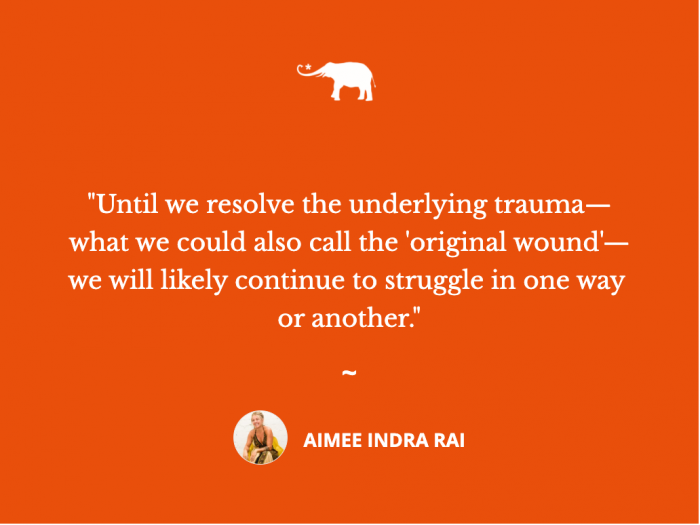View this post on Instagram
In the last weeks, Dr. Gabor Maté released a powerful and important documentary: “The Wisdom of Trauma.”
I cannot recommend it more highly and am so inspired by how well received it has been—a clear demonstration of how a trauma-informed mindset is slowly beginning to infuse our cultural consciousness.
That said, as a trauma specialist, I am also aware that many came away from watching the film feeling moved but confused. Confused because they see that they are symptomatic—that they are struggling with or have struggled with panic attacks, anxiety, depression, insomnia, eating disorders, OCD, ADHD, addictions, low self-esteem, or health conditions such as cancer, fatigue, chronic pain, or autoimmune issues—but remain unclear as to what the personal trauma is that underlies those symptoms and conditions.
Gabor conveys his belief that trauma underlies most mental and physical imbalance, but the movie fails to explore complex trauma—the type of trauma that most of us will be suffering with—more fully. The film gives a nod to the Adverse Childhood Experiences Study created by Dr. Vincent Filetti and his team at Kaiser Permanente, which confirmed how adverse childhood experiences (ACEs) such as physical or sexual abuse, neglect, parents’ divorce, or imprisonment can predispose us to mental and physical health problems later in life.
The study was groundbreaking, and I would highly recommend taking the test here. But, I would also urge you to understand that the study was one of the first of its kind and limited in its scope. Application of the ACEs study represents a significant shift in the medical and mental health fields—but it doesn’t go far enough.
We now know that trauma comes in many forms—mostly subtle and virtually undetectable to the untrained eye. This is so important to understand because in the words of Dr. Maté himself: “Until you understand what happened to you, on some level, you will continue to feel that your ‘issues’ are your fault.”
I can stand testament to this myself. I once struggled with addiction and alcoholism, depression, anxiety, and low self-esteem, eating disorders, codependency, chronic pain, and fatigue. My early recovery formed inside 12-step fellowships, and although I am deeply grateful for the support these groups offered me, they didn’t help me understand why I was the way I was, and as a result, I continued to suffer.
I got sober, but I was still anxious, periodically depressed, struggled in my relationships, was plagued with terribly low self-esteem and debilitating eating disorders. I worked all the programs dedicatedly. I would experience degrees of relief in one area only for issues in another to pop up. Eventually, under the love and guidance of other teachers and therapists, I started to put my puzzle pieces into place.
As I came to understand why I was the way I was, I began to heal in a way that was sustainable, easy, and all-encompassing. When I began to treat the trauma, I didn’t know I had suffered, my symptoms began to self-resolve. I see the same happen with my clients—when we work out what happened to us and begin to attend to that underlying trauma both somatically and psychologically, everything changes.
So, to understand ourselves with greater clarity, we need to understand what trauma actually is.
In simple terms, trauma is any experience that our nervous system was unable to process effectively at the time leaving that old emotional pain and stress stuck in the body. This stuck energy dysregulates the nervous system resulting in all manner of mental and emotional dis-ease and imbalance. Trauma can be caused by an acutely distressing one-time event, such as a car crash, rape, or even childbirth (what we would typically call post-traumatic stress disorder) or by exposure to various forms of emotional stress over a prolonged period of time such as financial strain or ill health (what we would typically refer to as Complex PTSD).
For the vast majority of us, however, most of the trauma will have originated in childhood (whether or not it eventually results in a formal C-PTSD diagnosis, which it often does). This is what we call developmental or attachment trauma. Many of us had stressful and emotionally wounding childhoods because society is suffering collectively—as “The Wisdom of Trauma” so beautifully conveys.
To understand childhood trauma, we need to look through the lens of the child. We need to understand that many things can be stressful or distressing to us when we are young and vulnerable.
As children, we are wholly dependent on our caregivers, for longer than any other mammal. Our survival, our life, depends on their ability to be attuned to our needs and meet them consistently. Therefore, it is actually quite easy for an infant to feel as though their basic safety is compromised. Any sense the baby or young child has that the parent is not attuned to them, is otherwise occupied with their own issues and anxieties, triggers a threat response in the child.
In the words of Dr, Maté, “Love isn’t enough,” and no matter how well-intentioned they were, if we grew up with caregivers who were consistently “stressed, depressed or emotionally unavailable” our sense of safety is threatened on a primal level, and we grow in a state of continuous tension and fear.
It can be hard to accept that our childhood was damaging in some way, so it is important to understand that this is not about creating bad guys or pointing a finger of blame—it is simply about self-understanding.
Beyond what is covered in the ACES test here is a list of just some of the things that can be traumatising for a child:
>> Birth
>> Adoption and Fostering
>> Being left to cry it out or having comfort withheld
>> Being smacked
>> Conflict between primary caregivers
>> Being frequently shouted at or rejected (think “time-outs”)
>> Financial instability in the home or having a caregiver that has to work long hours to provide
>> Having caregivers who are “stressed, depressed, or emotionally unavailable”
>> Having a caregiver who uses the child as a confidant, companion, counsellor, caretaker, mascot, or messenger
>> Having a caregiver who was unable to meet the emotional needs of the child in healthy ways, accept, and honour the whole child. Common forms might be being told not to cry, that “boys don’t cry,” or being punished for expressing anger or overwhelm
>> Having a caregiver who is strict, authoritarian, places pressure on the child to perform academically, or has a temper
>> Having a caregiver who lacks boundaries and provides little or no structure
>> Having a caregiver with rigid religious beliefs
>> Being mocked, shamed, belittled, or dismissed
>> Not feeling seen or understood
>> Not having appropriate adult emotional support through things like bullying, being moved around, or schooling that does not align with the child’s natural abilities.
I feel it is important to note that, in some cases, symptoms may be born from trauma suffered later on in adult life. However, what I have observed is that those who grow up in safe, stable, emotionally healthy homes tend to be more resilient to later life adversity. They may have a terribly distressing experience as an adult, but they are more able to process that experience and move forward from it without becoming symptomatic. Because these people are functioning from a brain and body that is already in balance, they are more resilient to the challenges of life.
Those of us who grew up in dysfunction and live in an already traumatised state are sadly predisposed to being traumatised over and again as our systems are already overwhelmed and therefore less resilient. A relationship breakup or a car crash for someone without significant preexisting trauma can be upsetting, but for someone with preexisting C-PTSD or post-traumatic stress, these experiences can be devastating, completely destabilising, and may become the tipping point that then provokes the onset of heavier symptoms.
I have written this article because one of the most common things I hear from those suffering with complex trauma is, “Maybe I’m dramatizing it. Other people have been through so much worse than me. I mean, I was never hit; I grew up in a nice home,” or something of the like.
Films like “The Wisdom of Trauma” are changing the world, but they also don’t tend to shine a light on this more common type of trauma. Charles L. Whitfield estimates in his book, Healing the Child Within: Discovery and Recovery for Adult Children of Dysfunctional Families, that between “80 and 95 percent of people did not receive the love, guidance, and nurturing necessary.”
So, I want you to know that I see you, that you have suffered, that your pain is valid, and that your symptoms are not your fault nor your personal failing.
In the words of Peter Levine, “Trauma is a fact of life,” and experiences that leave a trauma imprint take many forms. Until we resolve the underlying trauma—what we could also call the “original wound”—we will likely continue to struggle in one way or another.
Unfolding our past allows us to heal in the present and move forward into a future that is our own.
Uncover, discover, recover.
~









Read 12 comments and reply